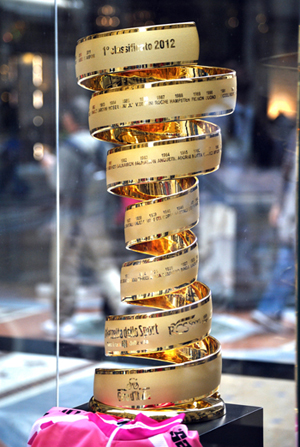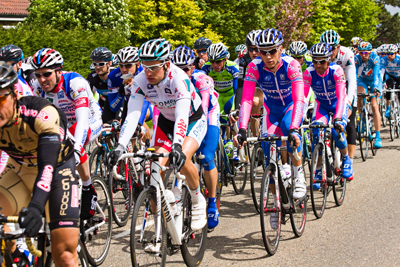 The trophy from the 2012 race
The trophy from the 2012 race
Belfast is turning pink. Quite a departure from the usual swathes of colours often associated with Northern Ireland as on this occasion, the city is hosting the Giro d’Italia’s Grande Partenza (big start) – one of the few occasions this has happened outside of Italy.
The Giro is second only to the Tour de France in the world of cycling and previously, cities such as Monte Carlo, Nice and Amsterdam have hosted the event. The eyes of the world are on Belfast this week, expecting great things from the place and its people, as 200 of the world’s top cyclists descend on our city.
And they will get it! Shop fronts, cafés, office blocks and even road signs are decked in pink bunting and temporary rose-coloured washes of paint across logos and pillars, transforming the city of Belfast into a pink paradise. Even Belfast City Hall will be lit up in a pink hue in honour of the occasion. All this, only four days after the Belfast City Marathon, is creating a new identity for the city of Belfast – one of sport, health and vitality.
This is significant, and truly exciting. It builds on Belfast the brand, making the city an exciting and rewarding place in which to live. This re-imaging of communities and the push to ‘Love Belfast’ has already taken off with recent top quality music festivals, the MTV Awards, filming for Game of Thrones, and various BBC dramas such as Line of Duty and The Fall. Belfast has definitely attracted the interest of the world for the right reasons.
The connection of bicycles to Belfast, however, has been underplayed until now. The city is the home of the Dunlop pneumatic tyre, first tested by the Scottish veterinary surgeon, John Boyd Dunlop, at his workshop in May Street - only a stone’s throw from the current Open University building in the city centre. By sheer coincidence, the ‘Big Start’ route passes close to Cherryvale Sports Ground where the tyre was tested on a bicycle, before Dunlop patented his invention in 1888.
Belfast is ahead of the pack in terms of cycling as a form of commuting. Census data from 2001-2011 reports that Belfast saw a 60% rise in the number of people cycling to work, while this number fell by 12% across the rest of Northern Ireland. Figures from the Department for Regional Development for this same period show that cycling has increased in key locations in the city by up to 152%, with activity in some of the most popular areas such as Stranmillis Embankment and the Albertbridge Road rising to an amazing 200%.
In 2015 Belfast City Council will launch a public bike scheme – the first of its kind in Northern Ireland – to capitalise on this trend, whereby 300 public bikes and up to 30 bike-docking stations in the city centre will be made available to members of the public. Similar to the Dublin bike scheme, this method of transport is expected to reduce fuel costs, encourage activity, decrease congestion and improve the efficiency of the current transport system.
It appears, therefore, that Belfast is on the move, in more ways than one. Sport is an interesting and strategic choice for place-promotion of the city and also in advancing its reputation onto new terrain. Sport has recently played a key role in what might be termed the ‘normalisation’ of Belfast, and the venues that host sporting events (for example, the Odyssey Arena) reflect the rise of designed urban spaces to facilitate economic growth through consumerism and spectator sport. Boxing is a particular example, and Carl Frampton’s recent fight attracted 9,000 fans inside the Odyssey Arena in Belfast, with a crowd of over a hundred outside – a hugely popular sport and sports personality. The Belfast Giants ice hockey following is a similar phenomenon encouraging the cultivation of non-sectarian sport in a neutral city space.

With sport increasingly gaining recognition here, Northern Ireland, although small, sure gets attention. All this activity has put Belfast on a global stage – as a place to visit, live, work and in which to invest. Seeing Belfast through the fresh eyes of outsiders is important when it comes to developing its reputation globally, especially with the continuing fragilities that exist in relation to the peace process and dealing with the past. The marketing potential of the city through the Giro promises to be massive, with TV coverage estimated to reach around 775 million people in 165 countries across the world. For this reason, Northern authorities are investing £4.2 million (€4.85 million) to stage the event, which is expected to generate at least £10 million (€11.55 million) for the local economy. With the next stage of the race taking place at world class geographical locations such as the Antrim Causeway Coastal Route and the cathedral city of Armagh, only 40 miles from Belfast, the city will be showcased as a central compass point in the island of Ireland, easily accessible to town and country and its neighbour, the Republic of Ireland.
The route of the Giro, in this sense, offers up some interesting analyses regarding the peace dividend that the Good Friday Agreement has brought to the island of Ireland. Joint tourism marketing of the island of Ireland is one of six areas of co-operation set up under the 1998 Agreement, through Tourism Ireland, an agency jointly funded by the Irish Government and the Northern Ireland Executive. With the relaxing of border controls for travellers crossing into the Republic in recent years and the opening up of direct roads connecting both parts of the island, the Giro route from Belfast to Dublin is symbolic of a growing acknowledgment of changed, but accepted identities, and of compromise and collaboration. The joint marketing of the event as taking place in ‘Belfast’ and ‘Dublin’- two identifiable, vibrant cities, rather than two separate political structures – speaks of smart strategy to attract tourists to this small part of the world.
In addition to the increased visibility of Belfast over the next few days with its fresh identity and sense of celebration being portrayed to the world, the long-term impact of the Giro event can only be beneficial to its citizens. First, we will see an economic impact. The high visitor numbers and spending in the city will bring a short-term economic boost to hotels, restaurants, transport providers, shops and bars. Then there is the social impact - the sense of excitement in the city and the competition for best-dressed (pink) building will create an atmosphere of conviviality, a sense of place and occasion, uniting people in sport for a moment in time. There are also health benefits. Promotion of cycling, coming so soon after the Belfast City Marathon’s promotion of running, can only be positive. The need to encourage young people to exercise, get fit, fight disease and illness and boost positive mental health is often overlooked in our busy, digital and virtual lives. The physicality of cycling creates spaces of adrenaline, endorphins and positivity. Given the latest figures released by the Department of Health, where 13% of people suffer with depression in Northern Ireland, physical activity is more important than ever to combat mental illness.
Citizens and visitors to Belfast will watch a rose-tinted city as the Grande Partenza cyclists speed through the streets on the 9th May. The city will be pink, vibrant and bustling. Belfast is on course, and its reputation is racing to the top.
Rate and Review
Rate this article
Review this article
Log into OpenLearn to leave reviews and join in the conversation.
Article reviews